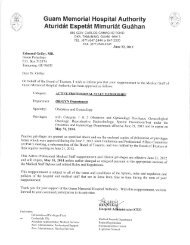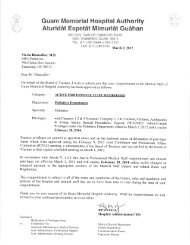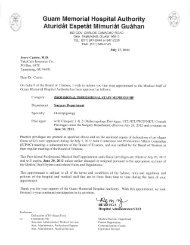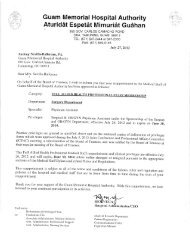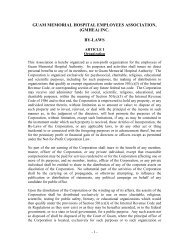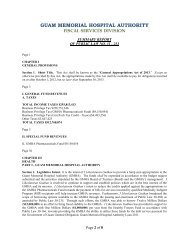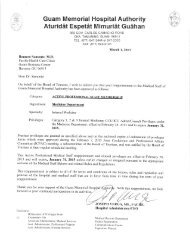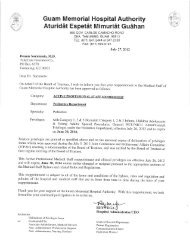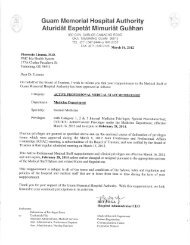GMHA Patient Privacy Guide for Media - Guam Memorial Hospital ...
GMHA Patient Privacy Guide for Media - Guam Memorial Hospital ...
GMHA Patient Privacy Guide for Media - Guam Memorial Hospital ...
You also want an ePaper? Increase the reach of your titles
YUMPU automatically turns print PDFs into web optimized ePapers that Google loves.
PATIENT PRIVACY GUIDE FOR MEDIA<br />
Introduction<br />
The first responsibility of a health care institution is to protect the health and welfare of its patients. With this in<br />
mind, it is the policy of the <strong>Guam</strong> <strong>Memorial</strong> <strong>Hospital</strong> Authority (<strong>GMHA</strong>) to respect and protect the privacy<br />
rights of patients, their families, employees and related third parties. Federal laws, including the Health<br />
Insurance Portability and Accountability Act of 1996 (HIPAA) and the HIPAA <strong>Privacy</strong> Rule of 2003 mandate<br />
regulations that establish standards to protect the privacy of each person’s individually identifiable health<br />
in<strong>for</strong>mation.<br />
The <strong>GMHA</strong> is obligated to ensure that patient privacy is protected and the facts it is authorized to release are as<br />
accurate as possible. In all cases, the <strong>GMHA</strong>’s first responsibility is to protect the confidentiality, health and<br />
legal rights of all patients.<br />
This guide has been prepared <strong>for</strong> news media professionals to provide an understanding of the hospital’s<br />
responsibilities and policies to protect patient privacy. This document is provided to help both the <strong>GMHA</strong> and<br />
the news media in communicating facts about patients with the protection of these patients’privacy as a shared<br />
goal.<br />
What is HIPAA?<br />
The Health Insurance Portability and Accountability Act (HIPAA), and ensuing related regulations, changed<br />
how health care facilities use and release patient’s personal health in<strong>for</strong>mation. More relevant to the news<br />
media, HIPAA limits how patient in<strong>for</strong>mation can be released to the public.<br />
What can be released on the condition of patients currently under treatment?<br />
<strong>Media</strong> requests <strong>for</strong> in<strong>for</strong>mation on the condition of patients currently under treatment at the <strong>Guam</strong> <strong>Memorial</strong><br />
<strong>Hospital</strong> or the <strong>GMHA</strong> Skilled Nursing Unit must be directed to the Public In<strong>for</strong>mation Officer during normal<br />
business hours and to the GMH Nursing Supervisor after normal business hours.<br />
Without a signed, written authorization from the patient, the privacy regulations allow a health care facility to<br />
release only the following in<strong>for</strong>mation:<br />
A general statement of the patient’s condition that does not reveal specific health in<strong>for</strong>mation (see below);<br />
and<br />
The location of the patient in the facility (e.g. Intensive Care Unit, Pediatric Ward), unless disclosing this<br />
would reveal protected health in<strong>for</strong>mation about the patient. For example, releasing that a patient is in the<br />
Operating Room would reveal that she or he is undergoing surgery.<br />
Revised 11/2009 Page 1
Requests must meet the following requirements:<br />
The media professional must ask about the patient by name. No in<strong>for</strong>mation may be disclosed if a<br />
request does not include a specific patient’s name.<br />
The patient has been in<strong>for</strong>med that this in<strong>for</strong>mation may be released, through the hospital’s <strong>Privacy</strong><br />
Policy, and the patient has not expressly stated that she or he does not want this in<strong>for</strong>mation released.<br />
What if a patient’s name is not available?<br />
Then no in<strong>for</strong>mation about the patient can be disclosed. While it may be difficult <strong>for</strong> the media to obtain<br />
names of certain patients, such as accident or crime victims, federal regulations prohibit the hospital<br />
from releasing any in<strong>for</strong>mation if a request does not contain a patient’s name. This measure is mandated<br />
by federal privacy regulations.<br />
What patient condition descriptions will be used?<br />
The following one-word condition descriptions, developed by the American <strong>Hospital</strong> Association, will be used<br />
<strong>for</strong> public statements in most instances:<br />
Undetermined –<strong>Patient</strong> is awaiting physician and/or assessment.<br />
Good –Vital signs are stable and within normal limits. <strong>Patient</strong> is conscious and com<strong>for</strong>table. Indicators<br />
are excellent.<br />
Fair –Vital signs are stable and within normal limits. <strong>Patient</strong> is conscious, but may be uncom<strong>for</strong>table.<br />
Indicators are favorable.<br />
Serious –Vital signs may be unstable and not within normal limits. <strong>Patient</strong> is acutely ill. Indicators are<br />
<br />
questionable.<br />
Critical –Vital signs are unstable and not within normal limits. <strong>Patient</strong> may be unconscious. Indicators<br />
are unfavorable.<br />
Note: While nurses and physicians often use the phrase “critical but stable”amongst themselves, a condition of<br />
“critical”by definition means that at least some vital signs are unstable. In general the AHA has recommended<br />
the term “stable”should not be used, especially in combination with other conditions which by definition often<br />
indicate a patient is unstable.<br />
What other in<strong>for</strong>mation can be provided?<br />
No patient in<strong>for</strong>mation that is not included in the <strong>Hospital</strong> Directory may be disclosed without express written<br />
authorization, according to the privacy regulations. Prohibited disclosures include:<br />
The age, gender or ethnicity of a patient;<br />
What the patient is being treated <strong>for</strong>; or the nature of his or her injuries or illness;<br />
How the injuries or illness may have occurred; and<br />
What procedures the patient is undergoing or is scheduled to undergo.<br />
Additionally, disclosure of a patient’s prognosis requires a written release from his or her physician.<br />
Can <strong>GMHA</strong> confirm a patient’s admission or discharge?<br />
Yes, if the request includes a patient’s name. Since this type of disclosure only provides in<strong>for</strong>mation on a<br />
patient’s general condition and location, <strong>GMHA</strong> can confirm to individuals who ask about a patient by name<br />
that the patient is being treated at the hospital or that the patient is no longer at the hospital. Disclosure of time<br />
and date of admission or discharge is not allowed.<br />
Revised 11/2009 Page 2
Can <strong>GMHA</strong> confirm a patient was “treated and released?”<br />
Yes. Under the HIPAA privacy rule, <strong>GMHA</strong> may disclose, to individuals who ask <strong>for</strong> the patient by name, that<br />
a patient was treated and released because this only provides the patient’s general condition (that they were<br />
treated at the hospital) and the patient’s location (that the patient is no longer at the hospital). No specific health<br />
in<strong>for</strong>mation may be provided and time and date of admission or release may not be disclosed.<br />
Can <strong>GMHA</strong> confirm a patient’s death?<br />
Yes, disclosing that a patient is deceased is a permissible facility directory disclosure as a statement of the<br />
patient’s general condition. A patient death may be confirmed by <strong>GMHA</strong> after notification of next of kin,<br />
provided that the above requirements are met. Cause of death and the time and date of death can only be<br />
released by the Office of the Chief Medical Examiner.<br />
What other regulations apply in special circumstances?<br />
Federal laws prohibit the disclosure of any in<strong>for</strong>mation about psychiatric, alcohol and drug abuse cases.<br />
Additionally, in<strong>for</strong>mation on patients who are on isolation or victims of sexual assault may be restricted<br />
pursuant to local and federal law and <strong>GMHA</strong> policy. Other restrictions may be en<strong>for</strong>ced subject to local and<br />
federal law and <strong>GMHA</strong> policy.<br />
Can in<strong>for</strong>mation be released on minor patients?<br />
The privacy regulations do not make special accommodations <strong>for</strong> minor patients’exclusion from the <strong>Hospital</strong><br />
Directory. Generally, minor children (under the age of 18) may have in<strong>for</strong>mation released with the consent of a<br />
parent or legal guardian, in accordance with the preceding guidelines.<br />
What if a patient is incapacitated and cannot consent to disclosure?<br />
If a patient is unable to state a preference about having his or her in<strong>for</strong>mation released, in<strong>for</strong>mation generally<br />
still can be released if the media professional asks about the patient by name. However, the hospital’s practice<br />
in these cases must be (a) consistent with a prior expressed preference of the individual, if any, that is known –<br />
such as if the individual has asked his or her in<strong>for</strong>mation to be private during a past stay. The release of<br />
in<strong>for</strong>mation also must be (b) in the individual’s best interest as determined by the health care provider, in the<br />
exercise of professional judgment. Both conditions must be true <strong>for</strong> a provider to release patient in<strong>for</strong>mation.<br />
What if details about a patient are already “public knowledge?”<br />
The fact that a patient’s personal health in<strong>for</strong>mation may already have been made public through some other<br />
circumstance does not affect <strong>GMHA</strong>’s obligation to protect that patient’s in<strong>for</strong>mation under HIPAA. Police and<br />
fire departments and other organizations are not entities covered under HIPAA, and often can release<br />
in<strong>for</strong>mation a health care facility cannot. In<strong>for</strong>mation in these cases will be released by the <strong>GMHA</strong> following<br />
the same guidelines <strong>for</strong> any other disclosures.<br />
Are interviews, photos and videos of patients allowed?<br />
Photographs, video or interviews can be granted only if a hospital representative obtains the patient’s written<br />
authorization. When the patient is a minor, written authorization of a parent or guardian must be obtained.<br />
<strong>Media</strong> must be escorted by the <strong>GMHA</strong> Public In<strong>for</strong>mation Officer or a designated representative at all times.<br />
Revised 11/2009 Page 3
What about patients who are public figures?<br />
HIPAA does not distinguish between public or private persons and ordinary or infamous injuries. A public<br />
figure does not <strong>for</strong>feit a right to privacy of their medical in<strong>for</strong>mation, and in<strong>for</strong>mation in these cases will be<br />
disclosed according to the above guidelines.<br />
What penalties apply to wrongful disclosure?<br />
<strong>Hospital</strong>s and individuals can face serious penalties <strong>for</strong> disclosing personal health in<strong>for</strong>mation about patients<br />
without proper permission. The Department of Health and Human Services views wrongful disclosure of such<br />
in<strong>for</strong>mation as a violation of civil rights and has delegated the civil en<strong>for</strong>cement responsibilities <strong>for</strong> the <strong>Privacy</strong><br />
Rule to its Office of Civil Rights. Criminal violations are referred to the U.S. Department of Justice.<br />
A person who knowingly uses, obtains and/or discloses private health in<strong>for</strong>mation in violation of these rules<br />
faces a fine of not more than $50,000, imprisonment of not more than 1 year, or both. A person who does so<br />
with the intent to sell, transfer, or use individually identifiable health in<strong>for</strong>mation <strong>for</strong> commercial advantage,<br />
personal gain or malicious harm faces a fine of not more than $250,000, imprisonment of not more than 10<br />
years, or both.<br />
Members of the press: Any person who uses, obtains and/or discloses personal health in<strong>for</strong>mation under false<br />
pretenses –such as if a reporter does not identify herself or himself as such –could be subject to a fine of not<br />
more than $100,000, imprisonment of not more than 5 years, or both.<br />
For More In<strong>for</strong>mation<br />
<br />
<strong>GMHA</strong> Notice of <strong>Privacy</strong> Practices:<br />
http://www.gmha.org/HIPAA/Notice%20of%20<strong>Privacy</strong>%20Practices%20<strong>for</strong>%20gmha.org.pdf<br />
<br />
<br />
<br />
<br />
<br />
<strong>GMHA</strong> Confidential In<strong>for</strong>mation Policy:<br />
http://www.gmha.org/HIPAA/Confidential%20In<strong>for</strong>mation%20policy%20<strong>for</strong>%20gmha.org.pdf<br />
U.S. Department of Health and Human Services’s Summary of the HIPAA <strong>Privacy</strong> Rule:<br />
http://www.hhs.gov/ocr/privacy/hipaa/understanding/summary/privacysummary.pdf (see Page 6, “Facility<br />
Directories”)<br />
45 CFR, § 164.510: http://edocket.access.gpo.gov/cfr_2002/octqtr/45cfr164.510.htm<br />
American <strong>Hospital</strong> Associations Advisory: HIPAA Updated <strong>Guide</strong>lines <strong>for</strong> Releasing In<strong>for</strong>mation on the<br />
Condition of <strong>Patient</strong>s: http://www.aha.org/aha/advisory/2003/030201-media-adv.html<br />
U.S. Department of Health and Human Services’s HIPAA <strong>Privacy</strong> Rule FAQs:<br />
http://www.hhs.gov/hipaafaq/administrative/483.html<br />
Revised 11/2009 Page 4



